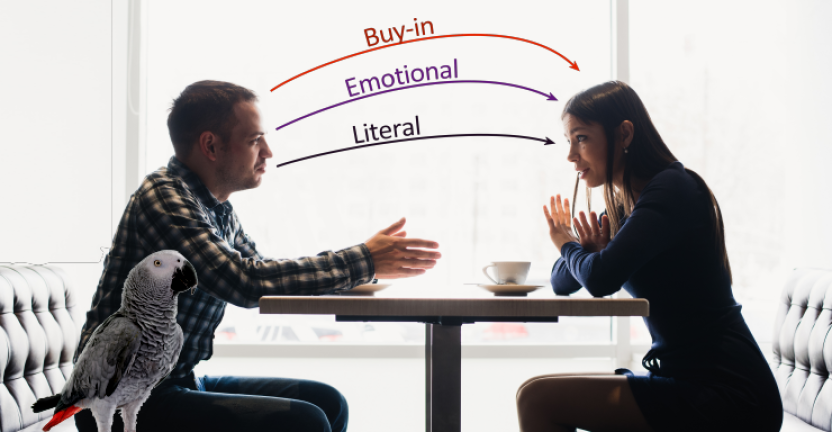Buy-in is Optional
Sometimes it is hard to remember that you actually get to select the things you care about.
There are a lot of causes to rally behind; a lot of traditions to follow; a lot of people who think “there is only one right way to do things” – and you are not obligated to care about any of it.
It is beautiful when you realize buy-in is optional.
My husband/editor sits on the Autism spectrum somewhere between Abed and Sheldon, with a heavy dose of Goofy. Some time after he was diagnosed in his forties, he was surprised to learn that in addition to the obvious literal message found in the text of words we speak, there is also a backchannel that includes an emotional message.
Now this is something the rest of us neurotypicals inherently know. We see the emotional message pretty clearly.
He sometimes asks me what the “real” or emotional message is. It is very cute. <3
So words are spoken, and two channels of information are delivered, right? Emotional and Literal.
But wait! We have recently identified a third channel of communication that is sometimes used.
We’re calling it: The Buy-In Channel.
The buy-in channel exists beyond honoring and respecting other people’s truth, which is humane and dignified – this is when someone asks you to honor a “truth” that is not yours at your own expense. Tricky concept here kids, stay with me…
Respecting someone’s truth is calling someone by their preferred pronouns, buying into their bullshit is when they tell you that you can only be respectful by changing yours as well.
Honoring someone’s truth is making sure they have a safe quiet space to retreat if you know that is what they may need.
Honoring and respecting someone’s truth means seeing them and acknowledging their worth. Buying into their bullshit means changing your behavior in uncomfortable ways.
They want you to be vegan or keto or vax or anti-vax or religious or liberal or conservative or pro-skittles or codependent or anti-parrot or whatever the fuck they are on about.
The buy-in channel is distinct from the emotional channel. You can be sad or angry or happy, and these and other emotions can be completely independent from how important it is for the receiver to buy in to the offer.
People will want your buy in. They may want their way of doing things validated, they may want company, they may want a tribe of followers, or they may want money, time, or resources.
The problem is that the buy-in channel is often invisible – hard to recognize – even for neurotypicals. And because it is hard to see, the buy-in channel can be used to harm those who unwittingly buy in to the offer.
Let’s look at an example. Let’s say you’re a mom with kids and you want them to visit for the holidays.
Approach #1 (Literal + Emotional + Zero Buy-in):
“Hey, if we get a chance to spend time together over the holidays, I think that would make me very happy.”
Here the literal matches the emotional component, and there’s no attempt to get buy-in.
Approach #2 (Literal + Emotional + a strong attempt at Buy-in):
“Don’t worry about me. I’ll just have Christmas dinner by myself. It’s alright. I’m used to being left alone by this family on a regular basis. I’ll just have to dip into savings so I can afford to buy a few extra boxes of tissues so I don’t run out like I did last year from all the sobbing. But don’t worry about me, being all alone, in what might be my last Christmas on Earth. You go ahead and spend time with the family you care about instead.”
Starting to see it?
The literal component is “don’t worry”. The emotion coming across may be sad/angry/resentful, or even (an insincere) happy, which can conflict with the literal message. And the buy-in attempt is complicated, but feels like it’s: “you don’t care for me, and you should have substantial guilt about that, so feel badly about yourself and do what I want“. The buy-in is essentially a request for you to adopt a particular emotion or way of thinking.
My husband theorizes that when humans are confronted with the mess of conflicting messages on the three channels (or even conflicting messages on two of the three channels), cognitive load increases, which makes it harder to see that the buy-in channel exists.
So it is always a good plan to check-in with yourself.
What is their agenda? What is yours?
The most important thing about the buy-in channel is its magnitude (how important your buy-in is to the other individual). If the magnitude is zero (no expectations but for you to be exactly who you are), then that is a very safe space to be.
But if the magnitude is high (e.g., imagine talking to a car salesman), then that space can be harmful and the efforts to get your buy-in can be insidious.
How important is your buy-in to them? That’s the magnitude.
Sometimes, when we’re in a gathering, we defer to the person with the most restrictive umwelt.
“We can’t curse because Blythe might feel uncomfortable.”
The unspoken message on the buy-in channel might be “we need to accommodate our behaviors to those we deem fragile.”
Okay, but I don’t buy in to the idea that Blythe is any more fragile than the rest of us, and even if I did buy into that, I don’t buy in to the idea that accommodating Blythe is in the best interests of everyone (including Blythe).
So why not simply allow everyone to be themselves?
“Mothers must sacrifice everything for their children; after all – they’re young for only a short time!“
Okay, but I don’t buy into your idea that I stop mattering as a person when I become a mother. So the rules you want me to abide, therefore, do not apply.
We all want to vote for candidate we believe in, but don’t you think it’s irresponsible to vote for a woman since only straight white males get elected?
The buy-in channel often reveals itself in the form of leading questions, like this one. Regardless, I don’t have to buy in to your predictions and paranoia, and I can always vote from a place of hope rather than fear.
I may be straying off course here; I am just really worried about the future of the world.
Back on track…
The buy-in channel is real; it often exists unnoticed; and most importantly: participation in that channel is completely optional, even when it may not feel that way.
Adherence to expectations, ways of eating, miserable perspectives, political views – all of it can be true for everyone else and STILL NOT BE TRUE FOR YOU.
We buy into things all the time that may not make any sense logically.
We buy into the idea that our hairdresser is the ultimate authority on our hair, the teacher is the ultimate authority on our kid, the person in the neighborhood who nominated themselves the leader is the ultimate authority on how should live in our community.
But mindless buy-in can really get us into a pickle, kids. It can have you doing all manner of things you didn’t expect to do, and don’t want to do.
It is a slippery place to try to stay balanced, teetering between accommodating others and being true to yourself. I frequently fall spectacularly on that oiled-up tile floor of a situation, but I keep trying.
So, if the anti-parrot people are on your case and you listen to your heart of hearts and confirm that parrots are indeed evil, well then you have found your tribe and a great place to complain about those little fuckers.
But… if you search the depths of your soul and find nothing but beauty in the ancient art of avian mimicry, remember that you create your own truth.
And their truth?
Well, buy-in is optional.














